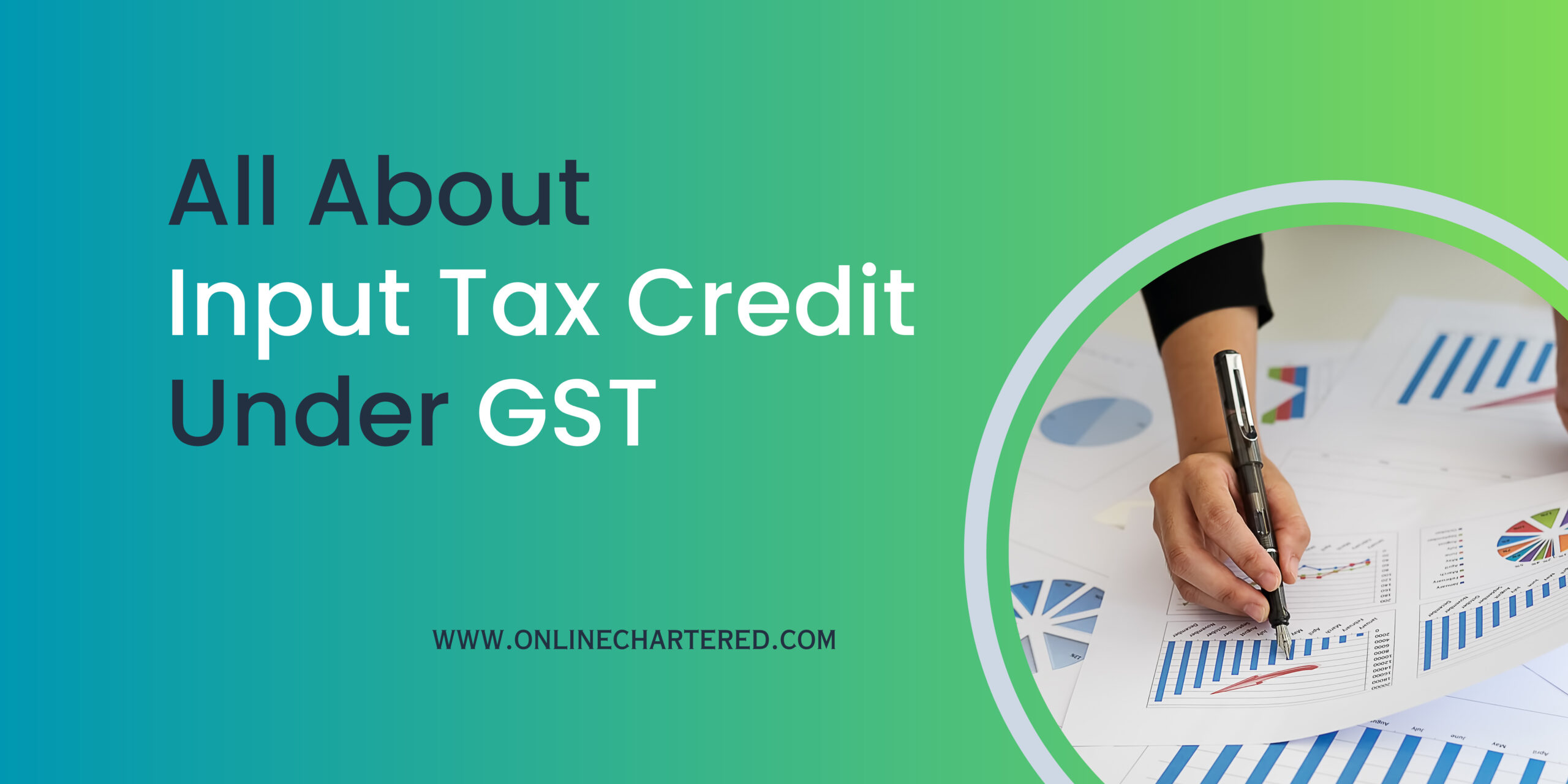Input Tax Credit under GST

Introduction :
Under the Goods and Services Tax (GST) regime, businesses can claim an input tax credit under GST to offset the taxes paid on inputs against the taxes they are liable to pay on output supplies. Claiming ITC is a significant benefit for businesses, as it helps reduce the overall tax liability and promotes the smooth flow of credits in the supply chain. However, it is crucial to understand and follow certain guidelines to ensure the proper claim of ITC. This article provides essential factors that businesses should keep in mind before claiming ITC under GST.
What is ITC?
The input tax credit (ITC) is the mechanism that allows businesses to claim a credit for the taxes paid on their purchases of goods or services. It is available at each stage of the supply chain, from the procurement of raw materials to the delivery of the final product or service. The ITC mechanism ensures that the burden of tax is not cascading and is effectively passed on to the end consumer.
Conditions for Claiming ITC
While claiming ITC, businesses need to fulfill certain conditions to ensure eligibility. The following conditions must be met:
1. Registration under GST
To claim ITC, a business must be registered under the GST regime and possess a valid GST identification number (GSTIN). It is essential to obtain registration before claiming any input tax credits.
2. Possession of a valid tax invoice or debit note
Businesses should possess valid tax invoices or debit notes issued by their suppliers. These documents must contain specific details, such as the supplier’s name, address, GSTIN, the buyer’s name, address, GSTIN, a unique invoice number, date of issue, description of goods or services, quantity, value, and applicable taxes.
3. Receipt of goods or services
To claim ITC, businesses must have received the goods or services. Merely making payments without receiving the goods or services is not sufficient to avail of the credit.
4. Timely filing of GST returns
The amount for the supply value and tax liability must be paid by the recipient to the supplier of goods or services, or both, within 180 days of the supplier issuing the invoice. If the recipient is unable to do so, the amount equal to the input tax credit (ITC) claimed by the recipient will be added to his output tax liability, along with interest, in a manner that may be specified.
Valid Documents for Claiming ITC
To substantiate the claim of ITC, businesses should maintain and possess certain valid documents. These include:
1. Tax invoices
Tax invoices issued by suppliers against the supply of goods or services are the primary document for claiming ITC. They should adhere to the specific requirements mentioned under the GST law.
2. Debit notes and credit notes
Debit and credit notes are issued when there are changes in the taxable value or tax charged on the original tax invoice. These documents play a crucial role in adjusting the ITC amount.
3. Bill of entry
In the case of imported goods, the bill of entry acts as valid evidence for claiming ITC. It contains details such as the importer’s name, description of goods, quantity, value, and customs duty paid.
4. Delivery challan
Delivery challans are essential documents in cases where goods are sent for job work, exhibitions, or any other purpose. They provide evidence of the movement of goods and are required to claim ITC.
Time Limit for Claiming ITC
Businesses must claim ITC within a specified time frame to ensure its validity. As per GST regulations, the last date for claiming Input Tax Credit under GST is the earlier of the following:
-
- 30 September of the next financial year.
- The date of filing the annual returns in form GSTR-9 relating to that financial year.
Reversal of ITC
Certain situations may require the reversal of ITC. Some common scenarios include:
- If the recipient fails to make payment to the supplier within 180 days from the date of the invoice, the ITC claimed on that invoice must be reversed.
- When the goods or services are used for personal purposes or exempt supplies, the proportionate ITC related to such usage must be reversed.
- If the supplier reduces the tax liability by issuing a credit note, the corresponding ITC claimed by the recipient must be reversed.
Types of credit
Precautions Before Claiming ITC
Before claiming Input Tax Credit under GST, businesses should take certain precautions to ensure accuracy and compliance. These include:
1. Match the invoices with the supplier’s GST returns.
It is essential to reconcile the invoices received with the details provided by the suppliers in their GST returns. Any discrepancies should be resolved before claiming ITC.
2. Verify the authenticity of suppliers.
Businesses should verify the authenticity and compliance status of their suppliers. This helps ensure that the ITC claimed is based on genuine transactions and reduces the risk of dealing with non-compliant suppliers.
3. Perform periodic internal audits.
Regular internal audits can help identify any errors or discrepancies in the ITC claimed. It is advisable to have robust internal control systems in place to mitigate risks and ensure compliance.
4. Educate employees and stakeholders.
Proper training and education should be provided to employees and stakeholders involved in the ITC claim process. This helps in understanding the requirements and avoiding any inadvertent mistakes.
Points to be kept in mind before claiming an Input Tax Credit under GST
- A tax invoice or debit note on a purchase created by a registered dealer can be made after the claimant has received the goods and services.
- The provider must pay or deposit the tax that is levied on the purchase with the government in the form of input credit or cash.
Common mistakes while claiming ITC
There are some common mistakes that businesses should avoid while claiming ITC:
- Incorrect or incomplete invoices: Failing to obtain valid tax invoices or debit notes can lead to the denial of ITC. Incomplete details or incorrect GSTINs can also create issues.
- Non-compliance with timelines: Failing to file GST returns within the prescribed timelines can result in the denial of ITC claims.
- Mismatch of invoices: Not reconciling the invoices with the supplier’s returns can lead to discrepancies and the potential rejection of ITC claims.
- Claiming blocked credits: Businesses should be aware of the items on which ITC cannot be claimed and avoid including them in their claims.
- Lack of documentation and record-keeping: Inadequate maintenance of documents and records can create difficulties during audits or assessments.
Conclusion
Claiming Input Tax Credit under GST is an important aspect for businesses to reduce tax liabilities and promote compliance. By adhering to the conditions, maintaining valid documents, and following the prescribed guidelines, businesses can ensure the correct claim of ITC. Precautions such as reconciling invoices, verifying supplier authenticity, and maintaining accurate records play a vital role in successful ITC claims. By understanding the nuances of claiming ITC, businesses can optimize their tax benefits and contribute to a more efficient and transparent tax system. contact us for more information.
FAQs
Q1. Can I claim ITC without a valid tax invoice?
A1. No, a valid tax invoice or debit note is essential to claiming ITC. It should contain specific details as required under the GST law.
Q2. What is the time limit for claiming ITC?
A2. Businesses must claim ITC by the earlier of the due date for filing the GST return for September following the end of the financial year or the date of filing the annual return.
Q3. Can I claim ITC on motor vehicles for personal use?
A3. No, ITC cannot be claimed on motor vehicles used for personal purposes. However, it can be claimed if the vehicles are used for specific business purposes as defined under GST rules.
Q4. What should I do if there is a mismatch between invoices and supplier returns?
A4. It is important to reconcile the invoices with the supplier’s returns and resolve any discrepancies before claiming ITC. Proper communication and coordination with the supplier can help rectify such issues.
Q5. How long should I maintain the records related to ITC claims?
A5. Businesses should preserve all relevant documents, including tax invoices, debit notes, credit notes, and reconciliation records, for the prescribed period as per GST regulations.
More related to Goods and Service Tax(GST):
Composition scheme for the service sector under GST
